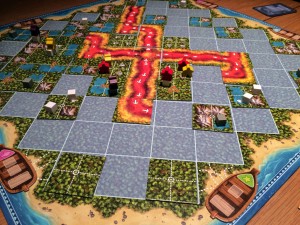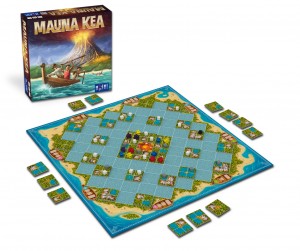Review: Mauna Kea
Posted by James (admin) on December 12th, 2013
 Mauna Kea is a game about explorers fleeing from an erupting volcano. This is not a co-operative game so players will be stepping over each other to take the boats along with as many artifacts as they can with them.
Mauna Kea is a game about explorers fleeing from an erupting volcano. This is not a co-operative game so players will be stepping over each other to take the boats along with as many artifacts as they can with them.
THE GAME
The board starts with many blank areas and the landscape will get filled in during the game. Landscape tiles (which get drawn from a bag) display 4 smaller squares which can each be of a different terrain type, plus each tile shows a number of movement points too.
Each turn, a player draws tiles from the bag until they have a total of 5 or more movement points. On their turn, players must use their tiles either for movement points to move their explorers, or for placing on blank areas of the board to reveal the landscape. Tiles with lava don’t count towards the player’s tiles and are immediately added to the matching lava flow (there are 4 different flows from the central volcano) and an arrow shows the direction too. Sometimes the lava flows split too.
Moving through water spaces costs more movement points than moving through jungle areas, and spaces containing mountains and lava block movement.
The players’ goal is to score as many victory points (VPs) as possible by moving their explorers onto boats at fixed locations around the island; however, each boat only has room for 1 explorer and there aren’t enough boats for every explorer. Extra points are scored by collecting and escaping with artifacts (17 white, 7 grey and 1 black in the game) – each explorer can only carry up to 3 items at a time but some boats have limited spaces for artifacts.
The game ends when one player has no explorers left on the island or the tiles run out. Players score for the explorers (3 VPs) and the artifacts they escaped with (white 1 VP, Grey 2 VPs, Black 3 VPs). Any boats used with empty artifact spaces earns -1 VP for each empty space; so, taking a boat that can carry 3 artifacts when you only have 1 artifact (assumedly because you like to put your feet up) will lose you 2 VPs, but at least a boat can never lose you points overall and does stop another player using it too.
The game comes with special cards for the advanced game. Some are one-use cards which give special actions like moving an explorer through any number of continuous jungle spaces, reorienting an already placed tile, or allowing an explorer to get helicoptered to rescue (although all of the artifacts they’re rescued are worth zero). Some cards score bonus VPs like having 2 explorers survive, rescuing 3 or more white artifacts, receiving no penalty for empty boat spaces, etc.
 THOUGHTS
THOUGHTS
Mauna Kea is a light eurogame that moves quickly and is simply about fun. Players need to balance placing tiles (thereby, making a safe and beneficial pathway) and moving their explorers along that path to safety. As well as progressing your own agenda, there is much gameplay in blocking off your opponents by placing difficult or impassable terrains, or explorers, in their way.
Choosing whether to use tiles for movement or placement is an interesting choice – I like multi-use items like this in a game. You draw your next tiles at the end of your turn so you can spend time working out how best to use your tiles on your next turn; however, things usually change quickly on the board as other players take their turns so don’t get attached to any plans you have. Fewer players means less changes between your turns (plus you start with more explorers so losing one is less of a hit).
Boats sailing and lava flowing instantly reinforces the brutal and fast-moving game pace which can result in some very funny events (depending upon if you’re the player who just had their explorers and artifacts wiped out). I like how the flows are automated so no player chooses where they flow. Having a few more volcano tiles and removing some unseen at random during set-up could have added some uncertainty about which streams would flow how far and how often.
I liked the advanced game cards and would always use those in my games as they give you extra variety to think about, especially the bonus points scoring as you’re not sure what people are aiming for. However, I might look to limit special action cards to playing 1 per turn, rather than unlimited numbers, as they can be very powerful when combined together.
The 16 starting tiles (which determine where the artifacts are) and 8 boats are placed on the board at random during setup, so the game starts differently each time which is good. It might have been nice to have a double-sided board with the other side having a different island and set-up for a bit of extra variety (i.e. a volcano towards one side of the island, or four separate volcanoes with one flow each).
I think Mauna Kea is a good game for families and lighter gamers (or even as a fun, quick game for experienced gamers). I think there was the opportunity to appeal to more gamers by adding some extra, advanced options. For example, an effect for carrying more than 1 artifact , i.e. spend 1 movement point on an explorer before moving them normally. Also, a way to wrestle artifacts off of other explorers; and, maybe lava tiles drawn don’t get placed until the next landscape tile whose movement point icons are red is drawn. Some optional rules like that could give a bit more control and decision-making to satisfy those wanting that.
, i.e. spend 1 movement point on an explorer before moving them normally. Also, a way to wrestle artifacts off of other explorers; and, maybe lava tiles drawn don’t get placed until the next landscape tile whose movement point icons are red is drawn. Some optional rules like that could give a bit more control and decision-making to satisfy those wanting that.
Any quibbles I’ve mentioned above are minor though and these are missed positives rather than negatives. Yes, there’s quite a bit of luck and, yes, there’s quite a bit of randomness; however, it doesn’t matter as Mauna Kea is (and is meant to be) an enjoyable, fun, fast and light-hearted game with excellent potential for screwage – just don’t stand in front of the lava flow if you don’t have to (which is good holiday advice).
You can read the rules on Huch & Friend’s web site: bga.me/maunakea
James.
[Played with 3 players]

